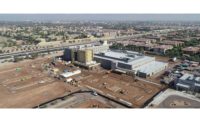Historic Expansion of U.S. Capitol Showcases Its Historic Use of CM
 |
| (Rendering courtesy of The Architect of the Capitol) |
The rise of the Capitol Visitor Center from dream to reality also has heralded another significant change on Capitol Hill. The $265-million underground facility, on a fast track for a 2005 completion, has propelled the Architect of the Capitol, the inhouse engineering and construction team in charge of the 19th Century legislative complex, to adopt 21st Century project delivery. The visitors' center is the architect's largest-ever building project and its first foray into outside construction management. The cultural change was not welcomed at first on Capitol Hill, but project participants now say the CM approach could make all the difference. The architect's office already appears to be confident enough that it has decided to go the construction-management route for renovation and modernization work it will be handling for the Supreme Court building. Hill International, Marlboro, N.J., was selected earlier this month as CM for the estimated $122-million, seven-year project, says a court spokesman.
Adopting CM was not easy at first, admits Alan Hantman, a former private sector architect who came on in 1997 as the tenth Architect of the Capitol. "We needed to wean our staff away from the concept that they had to do everything," he says. The office is responsible for nearly 18 million sq ft of space on Capitol Hill, including Senate and House office buildings, the Library of Congress, U.S. Supreme Court and other facilities. But with the scope of the visitors' center, "we recognized that we needed someone totally dedicated to it," he says.
 |
| SEQUENCE Center will be below historic Capitol grounds. (Photo top courtesy of The Architect of the Capitol) |
The three-level, 580,000-sq-ft underground project, located on the Capitol's east front grounds, includes theaters, an auditorium and other visitor facilities. Also part of the project are new pedestrian ramps, a new truck tunnel, tie-ins to two existing tunnels and excavation for 180,000 sq ft of new congressional office space.
RTKL Associates, Baltimore, had done design work on the center in the early 1990s but the project did not move to Congress' front burner until after the 1998 shootings of two Capitol police officers. Three years later, Sept. 11 resulted in a quick appropriation of $100 million that otherwise would have had to have been raised privately. The infusion of cash propelled the project, allowing for the security upgrades and a faster schedule. The new security considerations were a dilemma for project managers. "It's always a balancing act between accessibility and security," says Hantman. "This is the peoples' house."
The architect's office needed help on how to implement the more complex project delivery, turning to the U.S. General Services Administration for advice on planning, scheduling and procurement. The office also sought advice from the Army Corps of Engineers and Construction Management Association of America, including how best to handle project risks.
GSA was brought on to handle the CM procurement process. "We needed to get out on the street, to get the best and brightest to apply," says Hantman. GSA developed all documentation needed for the qualifications-based selection, which eventually drew interest from 22 firms. Complicating the process was Capitol Hill's exemption from most federal procurement regulations and strong oversight from a host of congressional representatives. Hantman says his office is prohibited to build using a design-build approach.
Providence, R.I.-based Gilbane Building Co. was selected as agency CM in January 2001, initially brought in at design development to monitor and inspect the general construction process. "The structural design was fairly well along when Gilbane came in, but changes were made to make [the center] more buildable," says Hantman.
Increased site support services, including a temporary visitors' screening facility and the cataloguing, dismantling and restoring of historic features, pushed Gilbane's initial $7-million contract to $16 million. It also performed a security analysis.
 |
| Contract packaging will expediate completion of work. |
"We had waited anxiously for the [architect] to select a construction manager," says Michael McQueen, RTKL project manager and vice president. "Means and methods are intertwined with the design. Construction staging and sequencing are now a critical design consideration."
To better control schedules and costs, Gilbane broke work into three separate packages–utility relocation, foundation, and general conditions, including mechanical, electrical and plumbing. "It was originally envisioned as a traditional design-bid-build project but this is a very difficult site and things got more difficult after Sept. 11," says Carl R. Jennings, Gilbane's project executive. "The three packages help clear the site so the contractor can come in and perform work as a production project as opposed to preparing the site and moving utilities in a time-consuming sequence."
The $8-million utility contract, begun last fall by William V. Walsh, Bethesda, Md., is now about 75% complete. "Over the last 100 years, utility lines of all sorts were woven through the fabric of the Capitol," says Hantman. Jennings says that the upfront utility relocation "minimizes risk and moves conflicts out of the footprint." Work also is in progress to move and preserve historic trees, some planted more than 150 years ago, as well as retaining walls, fountains and other landscaping touches created by 19th Century architect Frederick Law Olmsted.
Upfront work precedes the critical foundation contract, to be awarded shortly and worth as much as $100 million. To minimize feared disruption of congressional activities, the top-down work will gear up during summer recess. It will involve pouring 75-ft-deep slurry walls and using drilled shafts to place the column system within the footprint, says Jennings. The roof will be a slab-on-metal deck. "The slurry walls and top diaphragm brace existing foundations, which date from the early 1800s, the mid-1800s and the 1960s," he adds.
GSA has continued to handle contractor selection. "We're providing a part-time contracting officer and a project manager," says Robert Hixon, GSA's director of engineering and construction. He notes that among the architect's staffers, "there's still a little nervousness" about the outside participants. "Gilbane's role is to assist them, but they can only help as much as they are allowed. You have to have some trust." But Hixon admits that even at his own agency, which has used private CM longer and more extensively, cultural hurdles exist. "We're still trying to make the transition," he says.
Communication will remain a major hurdle for the CM organization and its clients. "The AOC staff has relationships with [congressional] members," says RTKL's McQueen. "The CM thing changes those relationships." Frequent briefings to members of Congress, especially those most involved in U.S. Capitol facility issues, are now a fact of life.
Hantman says the new approach seems to be working. "There's no question that [without] all the people Gilbane is providing, we would have had to provide them ourselves to control this project effectively," he says. "Why recreate the wheel when you have that expertise out there and the depth of a larger organization to pull from?"
| ...And Over on the Other Side of the Mall Rising within sight of the U.S. Capitol building is another high-profile construction management effort in the nation's capitalthe $110-million World War II Memorial. Since Gilbane Building Co., Providence, R.I., was first selected as the project's agency CM in May 1999, timing has been a critical factor. The memorial, across the Reflecting Pool from the Lincoln Memorial, is to be dedicated on Memorial Day, 2004. Project completion is set two months earlier, in March.
The use of an agency CM was a collaborative decision and a critical step for the American Battle Monuments Commission, which is funding the memorial, and the General Services Administration, its project manager. "We wanted to ensure this memorial received the highest degree of quality control and we wanted it delivered on time and budget," says Barry Owenby, commission project executive. The memorial consists of a 100,000-sq-ft plaza framing an existing pool, 56 granite pillars representing states, territories and District of Columbia, and two pavilions depicting World War II's Atlantic and Pacific theaters. An oval-shaped perimeter slurry cut-off wall will be used to support ongoing excavation of dredged fill by the joint venture general contractor, locally based Tompkins/Grunley-Walsh. Gilbane's initial $2-million contract for design and procurement phase services was amended last year to $4 million. It now includes construction phase services such as project administration, change management, daily coordination and quality and safety reviews. "Changes are mostly based on funding and timing, but phasing in is not unusual in CM work because it gives the owner a chance to review our work," says Bruce H. Hoffman, Gilbane senior vice president. In fact, the project last week underwent a GSA "peer review," normally done at 15% construction, says Robert Hixon, GSA's director of construction and engineering. "It's primarily a relationship check," he adds. Staying on good terms will be critical as tougher work starts. The finished site will be about 6 ft below current grade with less than optimal soil conditions. "It's dredged fill and the memorial needs heavy foundations," says Lawrence P. Rebel, Gilbane project mana- ger. "There is 100,000 cu ft of granite to be fabricated and installed. It's unique, with no consistent geometry." Participants are optimistic that use of CM will overcome the challenges. "Indecision kills projects," says Hoffman. "The CM process helps expedite decisions." |





